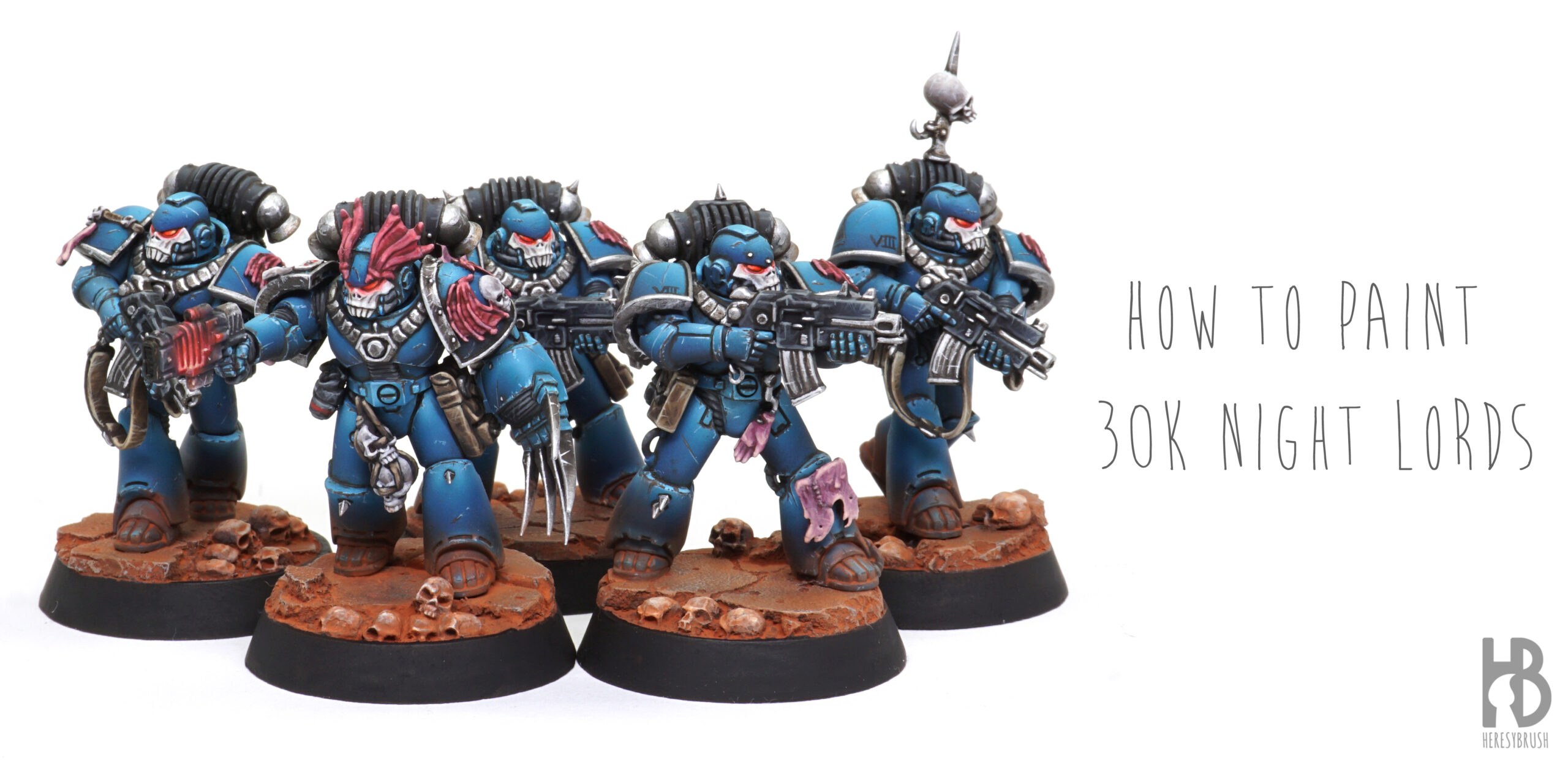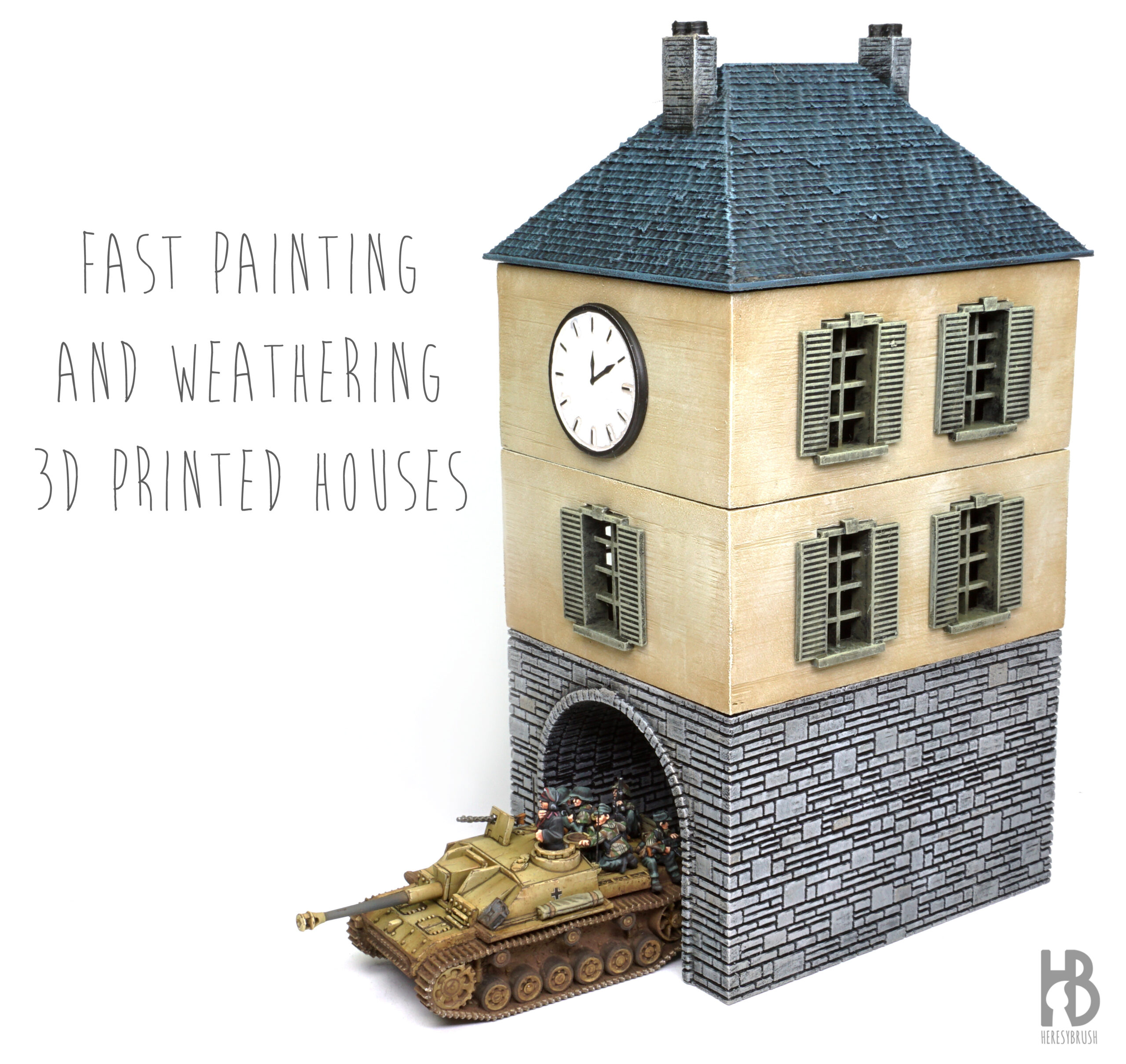In this article, we will explore how to create an anachronistic WWII camouflage, a “splinter camo”, commonly used by scale modelers for “what if” tanks and prototypes, such as the iconic German E series. To achieve this, we will use masking tapes to create an intricate tri-tone camouflage, where each color is carefully highlighted to create a striking contrast. This article was originally published on the Battlefront website, Part 1 and Part 2. The “What If” tanks open up endless possibilities for experimenting with color schemes and camouflage. Since these tanks never existed, the creative freedom is limitless. However, it…
How to paint WH30K Night Lords
After several years of wanting to start painting a Horus Heresy Legion army, I finally had the chance to do it. I chose the Night Lords, a Legion that is perhaps a bit underrepresented compared to others but features a beautiful color scheme and rich lore. I finished painting the first squad and decided to write a tutorial using the last miniature. Instead of the official painting scheme, which is very dark blue often with lightning on the armor, I opted for a desaturated and slightly greenish blue inspired by some great painters such as @loyalistareboring and @Maybug_Games on Instagram.…
How to paint 3D-printed buildings
In this tutorial, we will explore fast and simple techniques for painting 3D-printed houses made from filament, perfect for wargaming. Although we are going to paint a 15mm house for Flames of War, the same techniques can be applied to any theme and scale. The idea is to take advantage of colored primer cans for the base colors, and then create contrast using dry brushing and filters. Step 1 – Preparation Filament printers are an amazing tool for creating scenery elements for wargames with ease. However, the inevitable downside of this type of printing is the resulting linear texture. To…
How to paint tanks using the drybrush and oils
In this tutorial, we will explore techniques for enhancing a basic paint job using oil paints. Unlike acrylics, oil paints require an organic solvent like White Spirit or turpentine (which is toxic, such as Enamel Odourless Thinner A.MIG-2019) instead of water; and take hours to dry, as opposed to mere seconds with acrylics. However, this extended drying time lends oils the advantage of effortless blending, allowing for the creation of multiple effects. For instance, we can employ this property to generate shadows, thereby enhancing the sense of volume, or to simulate various weathering effects such as dirt or dust accumulation.…
Painting the WWI German AV7 tank: the art of enamel washes
This tutorial was originally published on the Battlefront website, here. Acrylic paints are the most popular choice for wargamers, and in most cases, the only option on the painting bench. This preference is quite logical, as acrylic paints are readily available, non-toxic, quick-drying, and overall user-friendly. However, if we take a closer look at what Scale Modelers do, we will discover that they employ a variety of paint types, including acrylics, lacquers, oils, enamels, and powder pigments. The distinct features of each type of paint can be utilized to perform specific steps or achieve particular effects. Therefore, having a understanding…
Winter camouflage using a washable paint
I recently published another post describing the “hairspray technique“, which is commonly used to create a “washable” white camouflage in scale models. During the WWII, this camo was done with a special type of white paint with little grip, so that it was easily removed with water during the thaw, causing effects of wear due to rain and rubbing of crew. However, we can create this type of camouflage following an easier approach with an specific acrylic product: Washable White Camo A.MIG 0024. We only need to apply a single layer and then activate it with water, skipping the…
Camouflages with Chipping Effects fluid (hairspray technique)
This article was published original on 4th of September of 2012. Updated on 4 of April of 2022. In this post we are going to see how to use a Chipping Effects fluid to create worn camouflages where the original base color is exposed. Basically, after painting the base color of the tank, the idea is to apply a thin layer of chipping fluid and on top of this the camouflage. After activating the chipping fluid with water, we will be able to remove small pieces of the camouflage paint applied on top. These Chipping Effects fluids replaces what classically is…
Color Modulation in 15mm
We have recently talked about several lighting systems for 15mm scale models (this post). One of these systems or styles is the so-called color modulation that we will discuss in further detail in this article. When painting 15mm tanks we can simply apply the desired color, for example olive green for a Sherman, and then just paint the details. But the results will be likely very flat. Furthermore, the tank will look very dark because small objects, such as our small 1:100 models, reflect less light than bigger size objects, such as the real vehicle. Therefore, it is very important…
How to paint a British Sherman tank, and a new book: Painting Wargame Tanks
It is a great pleasure to announce a new book published by AMMO of Mig Jimenez where I have actively been collaborating beside Mig Jimenez and Carlos Cuesta. The book contains 96 pages. After a short introduction about general materials and techniques (differences between acrylics and enamels, what is a filter or a wash, how to clean the airbrush…) you can find ten complete painting guides “step by step” of different tanks (mostly Germans, but there are also from USA and Soviet Union). The three firsts pretend to assimilate the knowledge showed in the introduction (we can say “basic level”),…
How to paint 15mm tanks: German spider mech
While I am learning new hobbies (and sports) in this lovely Finish land, such as ice swimming, ice hockey or cross-country ski, I had enough time to paint and prepare a painting guide featuring an interesting Panzermech from ClockWork Goblin miniatures. I love this theme! In the past, I painted a couple of walkers from DreamPod9, and I currently attempt to paint as many E-series tanks as I can from Forged in Battle or Heer46. All in 1/100 scale or 15mm, of course!, my preferred scale. In this occasion, I’ve prepared a complete painting guide. However, I want to notice…









